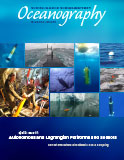First Paragraph
The upper ocean is a complex sea of lateral variability on scales ranging from less than a meter to many hundreds of kilometers. Small-scale processes, in particular those that happen within the wave-influenced surface boundary layer, often elude detection, except during highly specialized field campaigns. Observational challenges stem from the fact that large manned vessels heave and roll, inducing large relative velocities between sensor packages and the sea surface. Additionally, ship-induced stirring of surface waters can contaminate near-surface observations around a large vessel. Fast, seaworthy, rapidly sampling autonomous craft overcome some of these issues, and they provide a complementary means to sample complex three-dimensional upper-ocean processes on the relevant spatial and temporal scales. Such processes are often associated with the lateral stirring of freshwater from rivers, localized rainfall, and ice melt, which can form small-scale filaments and fronts that may control irreversible transports near the air-sea and ocean-ice boundaries. Elucidating the structure of the associated instabilities and turbulent fluxes permits better understanding of air-ice-ocean interactions and feedbacks.

